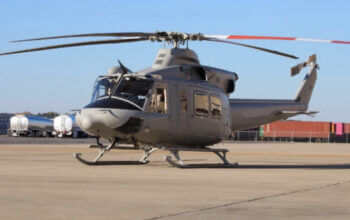Supply chain constraints are easing, but it’s still a challenge to meet the booming market demand for both new engines and in-service support, according to engine manufacturer Pratt & Whitney Canada (P&WC).
Irene Makris, the company’s VP of customer service, told Vertical that new engine demand is now at the same level as it was pre-Covid, while flying hours are about 20 to 30 percent higher than the same period.
“Demand is there — people are buying a lot of aircraft,” she said, speaking during HAI Heli-Expo earlier this year. “There’s a lot more demand coming, which means that our shops are also pretty busy because there’s more flying, which means people need more maintenance. So, I think from a [market] recovery [perspective], we’re there. Now, are we recovered? This is where everybody is challenged with the supply chain.”
Makris said the manufacturer has been ramping up production by 20 percent year over year to support the demand.
“I think we’re catching up. We’re there,” she said. “But there’s still some areas where our supply chain is being pulled . . . with all [aviation] market segments pulling on the same supply chain at the same time.”
She said P&WC’s main focus is on supporting its existing customers to keep them flying, and it has been working on “creative solutions” to support the in-service fleet.
This includes the offer of a “zero time since overhaul” (0-TSO) engine exchange to reduce downtime to just a few days, as well as the development of new repairs, subleasing engines, and granting time between overhauls (TBO) extensions on-wing.
“Where we have a parts issue, we’ve been able to do our engineering analysis to figure out if we can give a [TBO] extension to a customer,” said Makris. “They don’t have to come down and get AOG until we have the part availability for them. It’s case by case, it’s customer by customer, and it’s engine by engine.”
The biggest challenge with raw material is parts that require complex machining — and Makris said she doesn’t expect to see a full recovery on that side until mid 2025.
“I think this year we will continue to see flow improve — and that’s key,” she said. “But next year is when we’re anticipating a better recovery on some of the parts.”
To help more accurately forecast future market supply and demand, P&WC is leveraging artificial intelligence (AI) and machine learning, looking at the historical performance of suppliers and the requirements of the market.
“It may not help us right now — the problem is already there — but as we go forward, it will help us accelerate the recovery,” said Makris. “It will help the supply chain focus on the parts that are really needed.”
To give customers a better understanding of where their engine is when it has been sent for overhaul, P&WC is piloting a new digital tool that provides the ability to track an engine’s progression through the OEM’s shop.
Known as the “MRO Hub,” the tracking capability will give customers enhanced visibility and help them better plan their operations, said Makris — which is of particular use at the moment given the extended lead times caused by the supply chain squeeze.
Beyond addressing lingering supply chain issues, the company is continuing its work on sustainability and new technology for the next generation of engines.
This includes a hybrid electric demonstrator that promises a 30 percent reduction in fuel consumption. Currently, engines are sized for peak power requirements — takeoff and landing. P&WC’s scalable hybrid system uses a 1-megawatt electric motor to provide incremental power during those times of peak requirement, allowing a smaller turbine engine to be used for cruise flight.
The two engines in the system are running independently in test cells, but this year will see the first time the entire hybrid system has been run together.
In terms of sustainable aviation fuel (SAF) — the nearest available means for most operators to significantly reduce their carbon emissions — all P&WC engines are approved to run on a 50 percent blend.
Makris said P&WC is working with a consortium of aerospace companies, regulators and institutions to develop an agreement as to what an acceptable 100-percent SAF blend will look like.
“Customers are very interested in [SAF], but they’re interested in it at the right price,” she said. “The price is high and the availability isn’t. So I think this is where governments need to come and help push this a little bit forward.”









